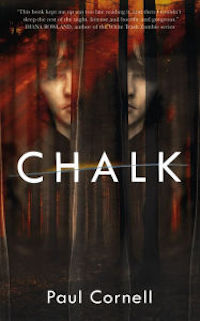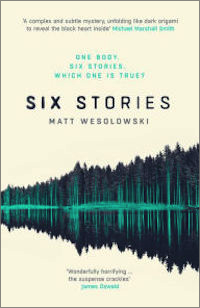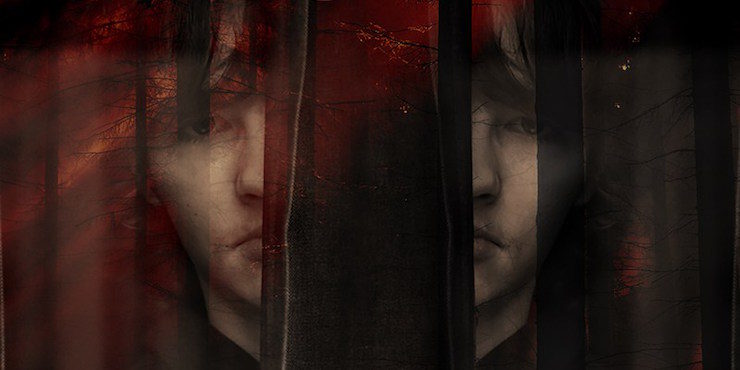I recently read Chalk by Paul Cornell and Six Stories by Matt Wesolowski in quick succession and both left marks. Chalk centers on the reminiscences of Andrew Waggoner, looking back on the horrific bullying he suffered at school and the equally horrific, possibly supernatural, action he took in revenge. Six Stories is a podcast in book form, interviewing six people connected to the still unexplained death of a teenager found out on the moors in the early 1990s.
Both books are fiercely clever examinations of rural adolescence and the things it can do to you. I saw familiar beats in both, recognised characters between the narratives, but most of all, I was captivated by the fictional space they share. The setting of Six Stories is left a little geographically ambiguous but the moors that Waggoner rampages across are in Wiltshire. It’s hard not to feel their calm, vast spaces are the extrusion into the novel’s space of the metafictional common ground it shares with Six Stories. That common ground, and what really happens when you go wild in the country, is what we’ll be looking at here…
Both novels are oral histories. Chalk, the novel, exists in its own universe in some form. We don’t know for sure if Andrew is writing everything down for an audience, crafting a manuscript, or just weaving the story for himself. We do know, especially in the way the novel folds in his father’s love of storytelling, that he’s telling the story. The ambiguity of how, or who it’s being told to, is strangely fitting both in terms of the novel’s own inherent ambiguity and for the purposes of this essay. The story is out there, somewhere. Where, and who it’s aimed at isn’t as important as its existence, a fact reflected in the redemptive/therapeutic way that Andrew approaches the telling.
Six Stories has a more rigid and more outward facing structure, which bakes its ambiguity in as well, but does so for slightly different reasons. The fact that it’s essentially a podcast in text form means that a structure is mandatory. We get six accounts of the same events, all at either one or two removes. The first remove is time: the interviewees all reminiscing about events that define their lives up through the present day but which have, at least, stopped happening. The second remove is present in the comforting anonymity of talking across Skype, or into a microphone to an audience who you can neither see nor even guess the size of. Six Stories gets a lot of logistical stuff about podcasting either wrong or fluffed for the sake of drama, but that feeling is perfectly captured: confessional reassurance shot through with dark espresso shots of adrenalin.
 That distance also allows both works to explore one of the elements that ties many of us together and certainly puts the two novels firmly on the same thematic playground (but, perhaps, on different sides…): both are sporadically and sickeningly violent in very different ways. The manner in which Andrew is maimed in Chalk is a literal and metaphorical breaking point for him and the novel alike. It’s one of those complex moments where horror becomes a flash bulb image of itself, the negative space left by the physical violence arguably as disturbing as the violence itself. You want his parents to find out, you want him to see a doctor, to be mended, to stop feeling the dreadful sensation of blood in his underwear. But Andrew, and the novel, are both trapped in the polite lie that sits at the heart of growing up: he’s caught in the center of a story where he’s a good boy. Good boys don’t suffer genital mutilation. Good boys don’t cause a fuss. Good boys get good grades and go on to greater things and the only person who notices their wounds is themselves. That’s the tragedy at the center of everything in Chalk, the involuntary social armor embodied in the old Del Amitri lyric:
That distance also allows both works to explore one of the elements that ties many of us together and certainly puts the two novels firmly on the same thematic playground (but, perhaps, on different sides…): both are sporadically and sickeningly violent in very different ways. The manner in which Andrew is maimed in Chalk is a literal and metaphorical breaking point for him and the novel alike. It’s one of those complex moments where horror becomes a flash bulb image of itself, the negative space left by the physical violence arguably as disturbing as the violence itself. You want his parents to find out, you want him to see a doctor, to be mended, to stop feeling the dreadful sensation of blood in his underwear. But Andrew, and the novel, are both trapped in the polite lie that sits at the heart of growing up: he’s caught in the center of a story where he’s a good boy. Good boys don’t suffer genital mutilation. Good boys don’t cause a fuss. Good boys get good grades and go on to greater things and the only person who notices their wounds is themselves. That’s the tragedy at the center of everything in Chalk, the involuntary social armor embodied in the old Del Amitri lyric:
Nothing ever happens, nothing happens at all…
The needle returns to the start of the song and we all sing along like before.
Andrew is thrown sideways and bleeding out of the narrative he thinks he’s in. His survival measure, as we’ll see, turns out to be something which only wounds him further.
The violence in Six Stories is less visceral but no less brutal. The Rangers, the club centered on outdoor pursuits that the main characters are part of, is an idea as lovely as it is naive. As the novel continues we see not only that eventual victim, Tom Jeffries, curdled the group from the inside out but that it was already well on the way there before him. That closed-fist, chambered punch feeling of late adolescence is in the DNA of Six Stories and its characters. The constant sense that something is about to happen. The increasingly loud voice telling you to MAKE something happen.
Just what happens and how much of it is real is very much open to debate. Both novels can be read in two different ways; the first is that everything we see depicted is metaphorical. That the terrifying “Marsh Hag,” Nanna Wrack—the story the Rangers tell one another as a test of nerve and cruelty—is nothing more than that. And that Waggoner, the persona that Andrew creates, is his way of dissociating himself from the horrific trauma he’s suffered and the simple fact that the wound, and the person who wounded him, are still part of his life.
The other way of reading these stories is simpler: everything is true.
Andrew Waggoner’s pain and trauma awakens an ancient intelligence coded into the hills of Wiltshire. It creates, for him, an identical double that is able to do everything he is unable or unwilling to. It shields this double from perception, just enough for it to not be noticed. It then uses Andrew’s need for revenge to break the accepted rules of modern reality in the hope of bringing back an age of blood and violence, powered by sheer adolescent fury. This leads to a series of increasingly brutal incidents at the school, and to elements of modern culture becoming unusually attuned to the flow of time.
Meanwhile, in this reading of Six Stories, Nanna Wrack is real. Something deathless and horrific stalks the countryside and the Rangers fall foul of it and of its passing.
Readers looking for certainty aren’t going to find it. Readers looking for stories that examine metaphors and delve into psychological fortifications as the site where natural meets supernatural are going to be much happier. Waggoner is Andrew’s healing process given form, his anger held at one remove in a massively British way. Nanna Wrack is an excuse, a collective hallucination talked/willed into existence by children who want to burn the world and, more importantly, want a reason why they need to cause this destruction, and worse, are able to.
 That restlessness is matched only by their cruelty. Jokes at other people’s expense, jokes at one another’s expense, and a carousel of hormone-drenched romance all hurtle past as the Rangers make their way into their final, catastrophic orbit. Bullies become victims, victims bullies, and the survivors of both novels are marked indelibly by their experiences and their relief, and guilt, at surviving them. Physical and mental scars abound and the grown characters of both novels are still, to varying degrees, defined by the actions of their childhood selves. That motivates them to tell their stories, to return to the feral countryside where they lost, if not themselves, then their illusions about who they thought they were.
That restlessness is matched only by their cruelty. Jokes at other people’s expense, jokes at one another’s expense, and a carousel of hormone-drenched romance all hurtle past as the Rangers make their way into their final, catastrophic orbit. Bullies become victims, victims bullies, and the survivors of both novels are marked indelibly by their experiences and their relief, and guilt, at surviving them. Physical and mental scars abound and the grown characters of both novels are still, to varying degrees, defined by the actions of their childhood selves. That motivates them to tell their stories, to return to the feral countryside where they lost, if not themselves, then their illusions about who they thought they were.
Meanwhile. Chalk‘s Waggoner stalks the hills of an endless summer filled with the promise of violence and the sense of something terrible and magical in the air. There’s a late sequence in particular in which a schoolyard fight metastasizes—it feels less like a character beat and more like a howl held for the entire book and finally released. There’s something of Graham Greene’s “The Destructors” to this sequence in particular: violence as destination, destruction as creation. Breaking something apart to make it work a different way, or using that process of destruction to break something other than yourself.
Six Stories goes a slightly different route. The cruelty here is at one remove, the scars healed over but no less apparent for the time that’s passed. What we know for sure we know by accretion rather than by direct, if perhaps unreliable, experience. Tom Jeffries was a victim. Tom Jeffries was a viciously abusive bully. Tom Jeffries was both. Where the feral, wild side of Chalk is embodied in both Waggoner and the almost hallucinogenic brutality that frequently possesses the narrative, the wild side of Six Stories is more predatory and considered. Chalk is a book about the moment before the punch is thrown. Six Stories is a book about the marks the punch leaves, decades later. Both are lost on the moors of amorality, running headlong into the feral, unfettered world of wild adolescence where someone you hope is Peter Pan waits for you with blood on his teeth and the skin torn from his knuckles.
The bravest thing about both novels is that both of them, to varying extents, remain lost out there. Andrew and Waggoner get their vengeance up to a point and no further. The world—whether through the pains of adolescence, the magic of pop music divination, or the impossibly old things that wait on the moors—breaks and then rebuilds itself. Each book and its leads walk right up to the edge of the deepest darkest woods and don’t quite step inside. It’s an intensely brave, muted way to end a novel and one that maps onto the ageing process with subtlety and even grace. We experience things at this time in our lives that scar us for decades to come. Andrew’s experiences leave literal scars, the embodiment of his masculinity permanently altered in a way that’s inextricably connected to his permanently altered view of the world. He never heals. Or rather, he never returns to normal. Because in the end, we all heal, even though there are times when we are desperate not to. But those experiences place him outside his own life. He remembers, too. He writes the book to remember the rest and, perhaps, to exorcise himself. A story carved in chalk—ephemeral, distinct, obtuse—but definitively there. Metaphor and memory, scars and recompense, all out on the moors and howling at the moon.
Where Chalk‘s Fortean approach enables and justifies this ambiguity, Six Stories isn’t as lucky. There’s a reveal in the final sixth of the book that is very well handled until it isn’t, and at the two or three points the novel creaks, it creaks very, VERY loudly. It’s interesting that the biggest issue is directly tied to the podcast narrative structure. In order for the book to land, the sixth act requires a frankly astounding cascading failure of systems that simply don’t break that way, ever, to take place. As a professional podcaster, that’s where I go into full-on eye roll territory. But purely as a story, it works. Barely.
Despite this, the novel still delivers an ending with surprising, and chilling, force. The killer isn’t Nanna Wrack. But Nanna Wrack and the killer may be both have been active on Scarclaw Fell at the same time and there’s a recurrent image through the novel that haunts the characters and readers alike: something that is either a man dragging a huge rucksack or something inhuman dragging itself across the moor. A shadow where there’s nothing to cast it. A blot on the landscape that stains everything behind it. That’s where the uncertainty in Six Stories differs from the supernatural ambiguity of Chalk. One leaves you with the feeling that something colossal and strange has brushed against the world. The other leaves you hoping that’s the case, because the other option is human and small and tragically, utterly broken.
Six Stories and Chalk use common experiences to tell uncommon stories. Both novels find the absolute worst in their characters and combine those depths with the tired, battered hope of endurance. By itself, that would be interesting, but coupled with the deliciously ambiguous approach both take to the supernatural, the effect is utterly haunting. Neither book is easy. Both books will stay with you. As they intend to. As they should.
Chalk is available from Tor.com Publishing.
Six Stories is available from Orenda Books.
Alasdair Stuart is a freelancer writer, RPG writer and podcaster. He owns Escape Artists, who publish the short fiction podcasts Escape Pod, Pseudopod, Podcastle, Cast of Wonders, and the magazine Mothership Zeta. He blogs enthusiastically about pop culture, cooking and exercise at Alasdairstuart.com, and tweets @AlasdairStuart.










